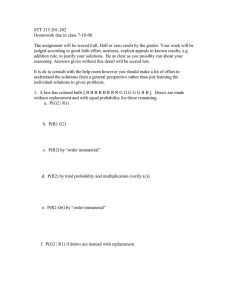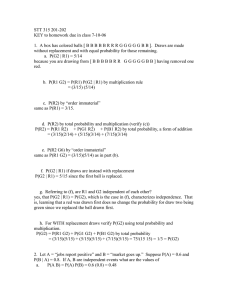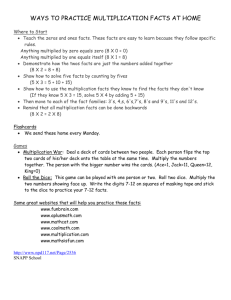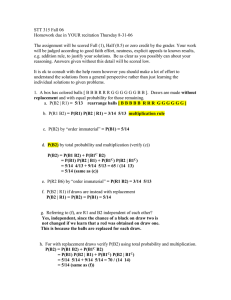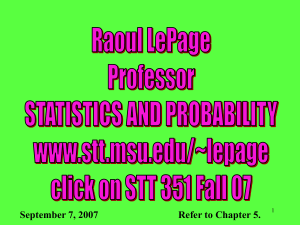STT 315 201-202 Homework due in YOUR recitation Thursday 8-31-06
advertisement
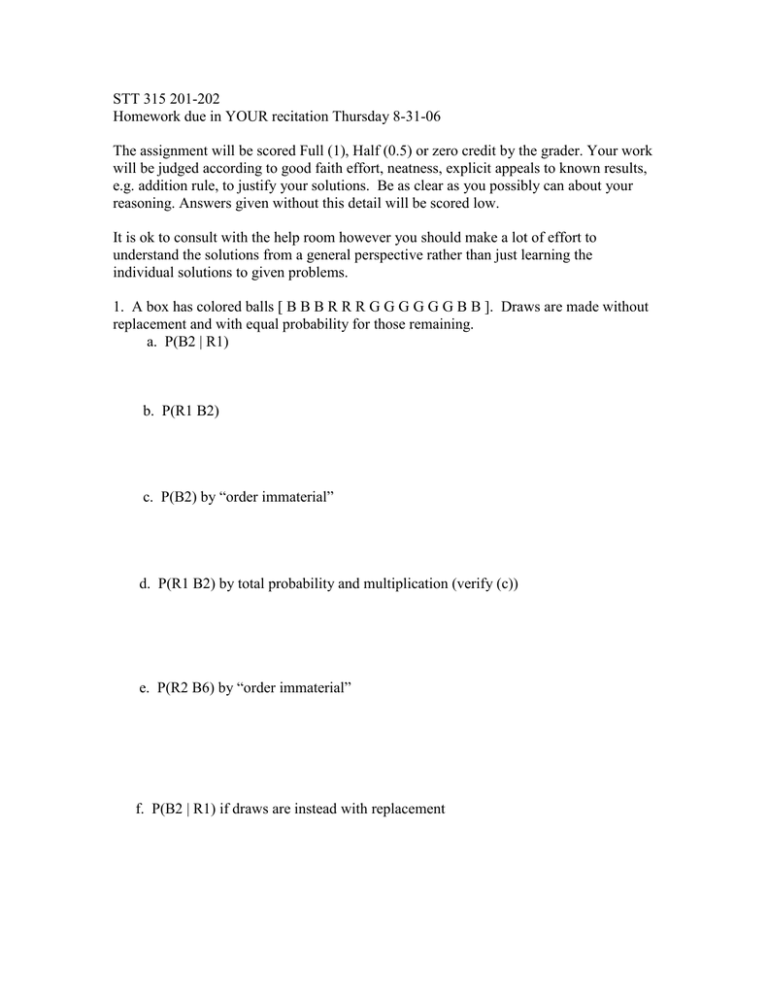
STT 315 201-202 Homework due in YOUR recitation Thursday 8-31-06 The assignment will be scored Full (1), Half (0.5) or zero credit by the grader. Your work will be judged according to good faith effort, neatness, explicit appeals to known results, e.g. addition rule, to justify your solutions. Be as clear as you possibly can about your reasoning. Answers given without this detail will be scored low. It is ok to consult with the help room however you should make a lot of effort to understand the solutions from a general perspective rather than just learning the individual solutions to given problems. 1. A box has colored balls [ B B B R R R G G G G G G B B ]. Draws are made without replacement and with equal probability for those remaining. a. P(B2 | R1) b. P(R1 B2) c. P(B2) by “order immaterial” d. P(R1 B2) by total probability and multiplication (verify (c)) e. P(R2 B6) by “order immaterial” f. P(B2 | R1) if draws are instead with replacement g. Referring to (f), are R1 and B2 independent of each other? h. For with replacement draws verify P(B2) using total probability and multiplication. 2. Let A = “market goes up” and B = “sales go up.” Suppose P(A) = 0.4 and P(B | A) = 0.9. If A, B are independent events what are the values of a. P(A B) b. P(A and not B) c. P(A or B) (hint, first find P(A and B)) d. Prepare a complete Venn diagram showing the probabilities of all four events AB, ACB, ABC, ACBC. e. If instead P(B) = 0.7 prepare a complete Venn diagram showing the probabilities of all four events AB, ACB, ABC, ACBC. 3. Red and green dice. a. P(R = G -3) b. P(R > G - 3) c. Prepare the probability distribution of R-G. 4. A first ball will be selected from [ R R R G G ]. If the selected ball is R then remaining draws will be made without replacement from [ R G G G B B]. If instead the first ball is G the remaining balls will be selected without replacement from [ R R R B G G ]. a. P(G1) b. P(G2 | R1) c. P(G2 | G1) d. P(G2) using total probability and multiplication. This will NOT be the same as P(G1) since draw one is not like the others. e. P(G3) using total probability and multiplication. 5. A coin will be tossed 4 times. The results of these tosses are independent. a. P(H1 H2 H 3 H4) b. P(H2 | H1) c. P(H4 |H1 H2 H3) 6. Events A, B are independent. P(A) = 0.8, P(B) = 0.3. a. P(A B) b. P(A or B) c. P(B | A) 7. Three cards drawn without replacement from a deck of 52. a. P(first card is not red) b. P(none of the four cards is black) c. P(all of the four cards are black) 8. Fill out a complete Venn for a. P(A) = 0.6, P(B) = 0.3, A independent of B b. Same as (a) but instead of independence we have P(A and B) = 0.1 9. If P(A and B) = 0.3, P(A) = 0.6 what is P(B | A)? 10. Which ones are likely to be independent? a. A = “I will sleep late tomorrow” and B = “you eat fruit tomorrow” b. A = “left engine of aircraft fails” and B = “right engine of same aircraft fails” if failures are due to birds drawn into the engine c. Same as (b) but failures are due to incidental breakdown and the engines are maintained in top condition 11. Each time a pair of dice is thrown there is probability 6/36 = 1/6 that the total will be 7. Toss a pair of dice 60 times to see how many of the 60 tosses (of a pair) produce a total of 7. Does this come close to 60 (1/6) = 10? 12. Explain why we work with probability models satisfying the rules obtained from classical probability.
